2020, as I’m sure you’ve heard many times, was a heck of a strange year. And to cap it off, I’ve got a heck of a strange Top 10 Video Games list for you.
Longtime readers might know that I don’t always play by the same rules for this annual listicle. The rule for candidacy this time around is simple: It must be a game that I played for the first time in 2020. That is it. That is the one and only criteria that I’m using to decide which titles are eligible. I’ve also decided to do away with the “must have beaten it” rule, because it seems unnecessary.
My selection process was this: I made a big spreadsheet of every game I played in 2020 (total of 118), removed any that didn’t meet my specification (47), and then narrowed it down to 28 frontrunners. From there, I simply looked at the list and picked the ones that I had the most positive emotional reactions to while reading their titles. By some wonderful coincidence, that left me with a clean list of 10 games. Neat!
And here are my selections, presented in the order that I played them:
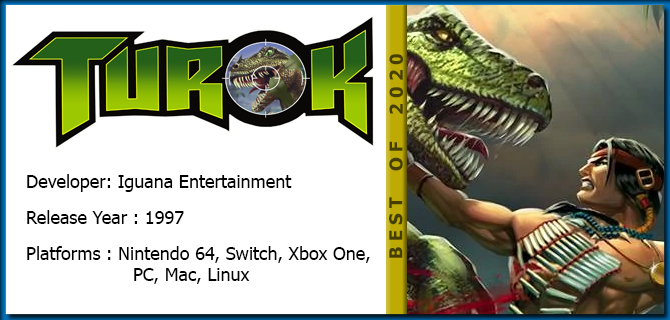
It’s a little strange to think that despite the relatively limited selection of games available on the Nintendo 64, I had never played this early hit until only this year.
Turok is a game about…Well, actually, I have no idea what the story was. I think this came out when a lot of video games’ stories were still confined to the manual. If there was any plot before gameplay began, it was completely lost on me. But your goal -as with most games of this vintage- is to kill everything that moves and explore the levels to find all the doohickeys that unlock the final stage. Murder the final guy at the end, and the world is saved, presumably?
What truly surprised me about Turok is that even as an early N64 game, it holds up incredibly well. There’s a lot of platforming for a first-person shooter, but for the most part it actually feels fine. It’s also worth noting that the game’s design isn’t strictly linear: you unlock stages by finding keys, and you can play any stage you like as long as it’s been unlocked. The stages are also huge, open, 90’s FPS-style playgrounds, more like something you would find in DOOM than in a Call of Duty. It’s also worth noting that the default difficulty balance is just about perfect: constantly keeping you on your toes and looking for health/ammo, but never to the point where it feels overwhelming.
All in all, I had an absolute blast playing Turok. It helps that I have a soft spot for this particular vintage of FPS, but I really do think it’s an excellent game. The remastered version also does it some favours by sharpening up the graphics and allowing you to play with a proper controller. I look forward to many future replays.

In 2019, Capcom released a remake of my all-time favourite Resident Evil game (RE 2), and I thought it was terrific. How would the remake of my most-forgotten Resident Evil stack up? Quite favourably, as it turns out.
Resident Evil 3 follows the further adventures of Jill Valentine, one of the two playable characters from the original Resident Evil. Taking place a couple months after the first game, this one has Jill trying desperately to escape Raccoon City, which is now completely overrun by the living dead. She also has to contend with a hulking monster who will stop at literally nothing to smash her into a fine paste, and a handful of special forces dudebros who may or may not be looking to help the situation.
A lot of people seemed to harbour a bit of a grudge against the RE3 remake, and I think that for the most part, they’re the ones who are big fans of the original version. I, on the other hand, very much enjoyed the major design changes that make this game more of a re-imagining than a straight remake. It’s significantly more linear and action based, having removed several areas from the original game, and almost all of the puzzles are gone. While I certainly like the design of the old-school RE games, RE3 remake is absolutely a lot more exciting and fun to play. You never get lost in the winding streets and alleys, looking for some random bauble to mash into a statue to open a secret passage. It’s all pretty straightforward, keeping you moving from beat to beat at a steady pace. Not to mention all the in-game achievements, difficulty settings, and unlockable items included to keep you playing again and again.
For my money, I think that Resident Evil 2 is an all-around better remake, but Resident Evil 3 is a heck of a lot more fun and creative. The ways that it plays around with the source material and your expectations are both surprising and exciting, and I am personally quite happy that Capcom decided to go off-script with this one.

Speaking of remakes that go off-script… I never actually believed that Square-Enix would come through with a remake of their most beloved game ever. But here it is. Well, here’s a part of it, anyway.
Final Fantasy VII Remake follows the adventures of Ex-SOLDIER Cloud and his eco-terrorist buddies in Avalanche, as they fight against the corrupt Shinra corporation that rules the city of Midgar with an iron fist. See, Shinra is literally draining the planet’s life force to power their giant metropolis, with absolutely no regard for the catastrophic environmental disaster that they’ve caused. Of course, some other things happen along the way to complicate matters, and the game ends at where you’d be about 1/5th of the way through the original. That may even be a generous fifth.
It’s very important to note that FFVII Remake ends in a very different way than the Midgar section of the original game. To the point where we have no idea what’s going to come next. I don’t think Square-Enix even really knows at this point. They could literally do anything they want, and that makes me super excited. But I didn’t only adore this game because of the sequel potential it carries. No, I actually thoroughly enjoyed the entire experience so much that I played the whole thing a second time immediately after beating it. And then I started a third playthough on hard mode, which got stalled at Chapter 4 because I’m not nearly good enough for hard mode. The combat is extremely fast-paced and asks for a surprisingly high level of competence from the player, even on the normal difficulty. As far as other noteworthy aspects? The extra time given to developing all the characters (both main and secondary) is very welcome, and I think that Aerith might even be my favourite character now? She’s just so darn charming and fun. This is huge, because I had no love for her in vanilla FFVII.
I could probably go on for a really long time about this one, but there are still seven more games that I have to type words about. I’ll just say it now: this list isn’t ordered by preference, but FFVII Remake is probably my favourite video game of 2020.
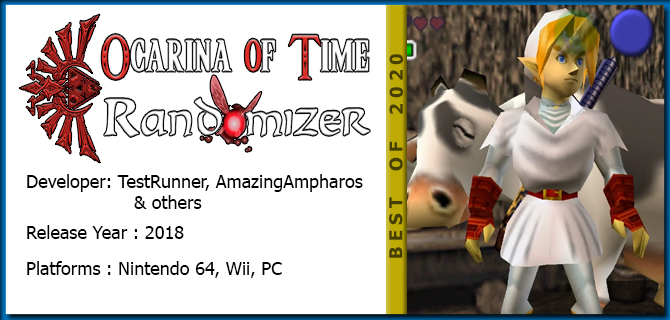
Okay, I’ll admit it. This one may be bending the rules a little bit. I’ve played Ocarina of Time like a thousand times on many different machines. But I honestly think that the randomizer adds enough new life into the game to consider it a totally different beast.
For the one person in the world who is not already familiar with The Legend of Zelda: Ocarina of Time, it’s the story of a young orphan named Link, who sets out on a magical quest to try to stop a great evil from conquering the kingdom of Hyrule. Surprisingly, things don’t quite work out, and the evil Ganondof succeeds in his conquest while Link is sealed away in stasis for seven years, so that he can give it another shot as a grown-up. This twist, and being able to explore a huge 3D world in two separate time periods was completely unheard of in 1998, and is a big part of why Ocarina of Time is widely considered to be the best video game of all time.
What the randomizer does, at the base level, is shuffle the locations of all the treasures in the game, whether you find them in a treasure box or in an enemy’s corpse or somewhere else. This alone will give you headaches, as you find important tools in the wrong places, and have to criss-cross the game worlds to try to figure out what you’re able to do at any given point. It’s an awesome way to re-experience Ocarina of Time, and actually requires a fairly deep knowledge of the game to truly enjoy. And if you want more, there are so many more options. You can add all of the shop inventories into the mix, turn on options that ramp up the difficulty, or just change out all the colours, sounds, and music to make the game feel like an insanely warped dream version of itself. My mistake was to include all of the skulltula tokens in the shuffle, which meant that any of the 100 gold skulltulas in the game could be holding a key item, vastly increasing what I needed to know and keep track of to win. Of course, that’s only scratching the surface of what the randomizer can do, and I absolutely recommend you give it a try to see what kind of crazy remix you can generate.
I had a blast playing through my randomizer seed, and I think that it was the closest I’ll ever come to being able to enjoy the game for the first time again. I’d also like to mention that watching co-operative speedruns of OoT randomizer seeds has been a huge draw for me lately. I can’t begin to estimate how many hours I’ve spent watching other people play this game. It’s honestly what really made me want to start streaming, even though I haven’t actually played OoT Randomizer on stream (yet).

Here comes something new. I haven’t ever placed a mobile game on a GOTY list before. I never would have thought that the first one would be a grindy Free-to-Play gacha game. 2020 was a strange year!
SINoALICE is the story of a handful of fairy tale characters that awaken in a strange world known only as The Library. There, guided by two puppets with questionable intent named Parrah and Noya, the characters battle it out against monstrous nightmares in the hopes of reviving their authors. Their motivations for doing so vary from character to character, and take inspiration from each character’s original story. Exactly how the story(/stories) unfolds isn’t always clear, because it’s told in little pieces, but that’s part of the charm. I like games that hand out little snippets of story and lore here and there, and leave it up to the player to put them all together. It’s also worth noting that most, if not all, of the characters are certifiably insane.
I’ll admit that SINoALICE only caught my eye, and probably only stays on my phone due to a strong attachment to the people who made it. The game’s director is none other than Yoko Taro, who is the creative mind behind the Drakengard and Nier games, which I happen to be a rather big fan of. The music is composed by the super-talented Keiichi Okabe, who scored the Nier games, which I strongly believe to have some of the finest soundtracks in all of media. As for the game itself, it’s a typical mobile gacha game, where you spend premium currency to maybe get some cool things that help you progress. It’s called an RPG, but battles aren’t especially deep, and most of the time, letting the game play on auto mode will be more than sufficient. What’s really fun to me is the PVP mode, The Coliseum, in which your guild is pitted against another in a daily battle for loads of prizes. Even though, as a casual player in a casual guild, I tend to see a lot more losses than victories, the battles are usually still really exciting. There’s a really good push-and-pull element when two evenly-matched guilds go at it, which makes it a lot of fun to participate.
While SINoALICE more or less boils down to a daily grind like most FTP games, The Coliseum and a constant torrent of events keep it interesting. I’ll probably keep playing it for some time to come. All because I’m a big simp for Yoko Taro.
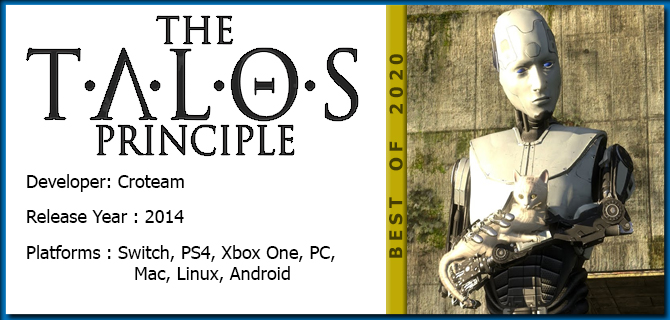
Every year, there ends up being one game that sort of “defines” my summer. Or at least, dominates the video game-related memories of my summer vacation time. For the year 2020, this is that game.
The Talos Principle is set in a post-apocalyptic future, although you wouldn’t know that by looking at it. The landscapes that you see from the outset are beautiful gardens lined with Roman-style architecture. Granted, it’s in a state of disrepair, but it still doesn’t seem all that bad. As you travel between different lands, each themed after a different time and culture from human history, you slowly piece together the plot: you are an AI, created to learn and grow and succeed the human race after an unspecified mass extinction event. Many AIs came before you, but they were either destroyed by the world or themselves. The lucky ones were able to ascend to a higher plane, passing on their learned knowledge to later generations. It’s a somewhat complex and deeply philosophical plot, and I enjoyed it immensely.
That said, the gameplay portion is not slouch, either. Taking inspiration from games like Portal, The Talos Principle is a first-person puzzle game where your goal is to clear a number of puzzle chambers on your way to your ultimate destiny. As you proceed through the game, puzzles grow more complex, add new elements, and even challenge you to solve meta-puzzles outside of the defined puzzle chambers. It’s brain-busting stuff, and oh-so satisfying to solve your way through each problem. Some of the optional challenges are incredibly complex, and really require you to think outside of the box to solve them. You also get to have a bit of a philosophical debate with another AI throughout the course of the game, and how you go about that ends up affecting the plot and ending. Finally, there’s an extra DLC chapter that takes place after the main game in a secondary simulation, and it is very possibly the best DLC expansion I’ve ever played. It successfully builds on the themes of the base game while also going in a completely different direction, and it is just as interesting and satisfying as the main game. Oh, and also the new puzzles are great too.
I already wrote a whole lot of words about this game earlier in 2020, and I don’t remember exactly what I said, but I’m pretty sure it’s nothing but gushing praise. There’s literally nothing that I dislike about it. I’d also be willing to bet that I had predicted that The Talos Principle would land on my 2020 Game of the Year list.
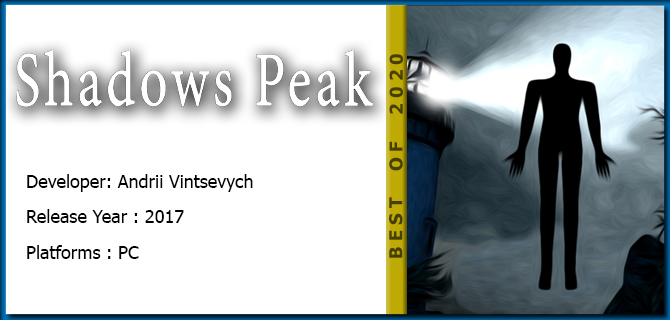
You want something else really weird, how about an indie horror game developed by a single person? Wait, what? That’s not unusual in 2020? Oh. Well, then…
Shadows Peak follows the story of a man named Tom as he explores a spooky, spooky island in search of his girlfriend(?), Michelle. Along the way, you’ll read stories about witches and serial killers and other spooky things that are part of the island’s history. You’ll also have to deal with ghosts that try to jumpscare you, a possessed teddy bear, and beached whale carcasses that may or may not be the most frightening part of the game. After certain events, the perspective switched over to that of a different character, and… things change. Suddenly the walking simulator becomes a first-person shooter, and you’re tasked with hunting down a chupacabra in a giant forest.
I’ll start by saying that the story and gameplay shift at the midpoint of the game is probably my favourite part of it. There aren’t many games that pull the rug out from under you in this way, and I completely adore when I am genuinely surprised like that. It’s not as masterfully executed as say, Frog Fractions or Doki Doki Literature Club, but it certainly cemented Shadows Peak as a game that I will never forget. I also do like the actual gameplay portions and the little bits of lore scattered about the game. It’s not the most compelling story in all of video games, and the gameplay doesn’t do anything revolutionary, but it’s still interesting and fun. Plus, there are a handful of incredible and highly effective spooky moments.
Shadows Peak is one of those games that I think is greater than the sum of its parts. To most, it will appear to be just another somewhat janky indie game. But I thoroughly enjoyed the almost-five hours I spent with it, and will continue to sing its praises for the rest of my days.

Speaking of indie horror games created by a lone developer… this is not one of them. But it’s based on a highly-successful series of them! And that’s my segue. Deal with it.
FNAF VR is, at a surface level, a sort of “greatest hits” compilation of the first five FNAF games. Consisting of dozens of minigames that are pulled directly from or inspired by the games that came before, it takes those simple 2D games and recreates them in immersive VR. But that’s not all that it is! The framing device for these minigames is that you’re a tester for this VR game, which is being made in-canon to try to salvage the reputation of the Freddy Fazbear’s Pizza franchise. It’s a little convoluted, and only gets more so when you learn that a bug which has been plaguing the developers is actually the digitized consciousness of the child-murdering villain from the previous games, which is attempting to use the VR game (and voodoo magic, presumably?) to possess you and escape back into the real world. Totally nuts. And it’s all just a big set-up for the story of the next game/s in the franchise.
Putting the coo-coo bananas story aside, the gameplay is really the star of the show here. As I said before, FNAF VR is more or less a VR recreation of previous games, so it might be hard to really appreciate if you haven’t been following the series. Lucky, I, being a massive FNAF fanboy, am the exact target audience for this game, and I was not at all let down. Being able to step into the actual space of the FNAF1 office is just short of a revelation, and made me all kinds of giddy. Then the animatronics started stomping down the hallways towards me and I peed my pants in terror. There’s plenty more variety than just FNAF recreations, though, with certain other games that involve navigating around a monster in a pitch-black room, or inexplicably solving puzzles in a vent shaft to bring a furnace back online. Each mini-game also includes a harder variant, which is where the creativity really starts to flow, as some of them are absolutely wild. And terrifying. They also tend to be terrifying.
FNAF VR is fan service – the ultimate fan service – and it had me constantly rocking back and forth between pure glee and abject terror. I’ve also written plenty about this game already, so you can go read those accounts if you’re interested in more of a deep dive on the game and why I think it affects me the way it does.
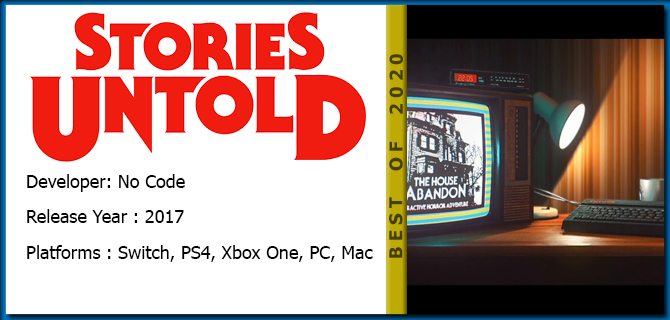
This is going to be the fourth game on this list that can be filed under “horror”, which says a lot about me and my tastes. I would like to put forth the claim, however, that while Shadows Peak and FNAF VR are admittedly more… acquired tastes… Stories Untold is genuinely incredible and anyone should be able to appreciate it.
Stories Untold, as the title suggests, is actually a series of four short tales. The first one is about a man visiting an empty old family home, and exploring the memories and relics that were left within. The second story puts you in the shoes of a fellow tasked with performing tests on a mysterious object at the behest of an unseen scientist. The third story has you situated in an arctic monitoring station, using various codes to send various data supplied by adjacent stations to your superiors. The last story is about a patient suffering amnesia who is working through therapy to try to recover his memories and reconcile his past. Each story takes maybe an hour at most to play through, depending on how thorough you are and how competently you can solve the puzzles.
As far as what “playing through” really means – it’s actually quite different for each story, ranging from a text adventure to using microfiche to crack codes to exploring an empty hospital in first-person mode. The variety here is great, and I really do appreciate the lengths that the developer went to to make each story feel unique. But the real star of the show are the stories themselves. They all start off a little eerie, but each one eventually twists into straight-up horror territory, and each in a different way. The atmosphere is tense and incredible, and though it took a little while to really get into the first story, once it clicked I was hooked until the very end.
This is another example of a video game doing an incredible job of subverting my expectations. I really don’t feel like I can say too much more, because I believe that Stories Untold is a must-play kind of game, and seeing how it all plays out first-hand is integral to the experience. There was never a doubt in my mind that this one would make the final cut for this list.
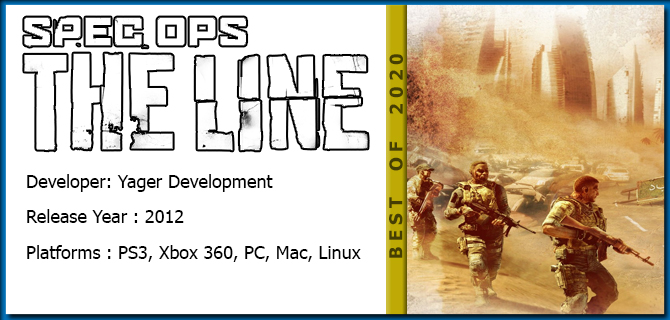
And now, at the end of the list, we finally circle back around from a bunch of oddball indie games to something a little more mainstream-friendly: A video game about burly army men shooting and killing impossible numbers of people.
Spec Ops: The Line tells a somewhat different story than most other dudebro shooting games. At the outset of this mission, your character, Captain Walker, and his two squadmates, Addams and Lugo, are on a mission to find and report the whereabouts of an AWOL American infantry battalion, the Damned 33rd. The first twist is that it takes place in the ruins of Dubai, which is in reality a city known for its opulence and extravagance. Things go awry right off the hop, as Walker’s team is ambushed by a local resistance group, and they learn that the 33rd’s goal of rescuing the people of Dubai has apparently given way to a hostile takeover. Over time, things get worse and worse, with the game forcing you to make several impossible choices and commit a number of atrocities. By the end, Walker’s original mission has been abandoned, his self-imposed mission has failed, and he is forced to reflect on the things that he’s done in Dubai, and what was really driving him the whole time.
If you haven’t clued in to it yet, Spec Ops: The Line exists as a counterpoint to all of those video games that glamourize war and violence. It wants you to feel bad about all of the death that you leave in your wake. It wants you to feel guilty about the murder and destruction. Of course, very little of this comes across clearly until later in the game, when Addams and Lugo start questioning Walker’s actions and orders, and the game itself even starts displaying phrases like “Do you feel like a Hero yet?” on the loading screens instead of control explanations or gameplay advice. It has to be said that all that murder and destruction is still pretty fun, because it has to be to sell a video game, but also because it’s important to driving home the themes. Why have we turned war into such a popular pastime? Why are we so driven towards violence? And why, even when it’s clearly the wrong option, do we work so hard to come up with reasons to keep committing violence? If I didn’t know better, I might think that Yoko Taro had a hand in writing this game.
Like any especially poignant piece of media, this one has really stuck with me even after I finished it. For a game that completely bombed, it has a small but very passionate fanbase, and plenty of deep, thoughtful analyses of it are out there to read. Spec Ops: The Line isn’t quite a masterpiece, but I think it deserves far more respect and mindshare than it currently gets.
And that’s it! Look at all those games! It’s quite a diverse bunch, don’t you think? A good mix of big-budget and indie titles. Some shooters, some adventures, some puzzles, lots of horror. A few underdogs and some overwhelmingly basic choices, and representation for a lot of different platforms. Most importantly, it’s only partially composed of sequels and remakes, as opposed to the 2019 list, which was almost entirely sequels and remakes. I think I’m growing as a video games enthusiast.
In the interest of giving credit where credit is due, here’s the full list of games that were eligible, but didn’t quite make the cut. Again, presented in the order that I played them. All of these are solid games in one or more ways, and I give my seal of approval that each one is worth playing. They just didn’t spark joy in me the same way that my final selections did.
- Threads of Fate (Playstation)
- Sol Seraph (PS4)
- Murder By Numbers (Switch)
- Piczle Cross Adventures (Switch)
- Shantae and the Seven Sirens (Switch)
- A Hat in Time (Switch)
- Paper Mario: The Origami King (Switch)
- Ellen (Switch)
- Black Bird (Switch)
- God of War (PS4)
- Oxenfree (PC)
- Rez Infinite VR (Oculus)
- Mission: ISS (Oculus)
- Genshin Impact (PS4)
- Hyrule Warriors: Age of Calamity (Switch)
- Paratopic (Switch)
- Fitness Boxing 2: Rhythm & Exercise (Switch)
- Witch Hunt (PC)
